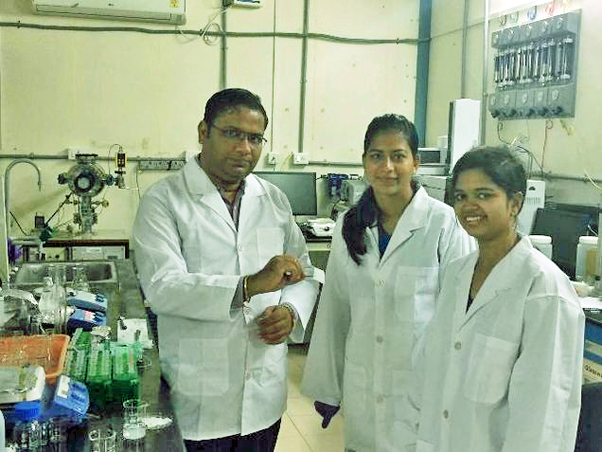Indian Scientists Develop Hyper-Absorbent Sanitary Napkins
![]() Print this Article | Send to Colleague
Print this Article | Send to Colleague
Sanitary napkins, which have greater absorption capacity than commercially available ones and can be safely disposed of due to their biodegradable nature, may soon become a reality thanks to research work carried out by a team of researchers from the Indian Institute of Technology, Hyderabad.
Most commercially available napkins use cellulose fiber to increase their absorption capacity. But the lower surface area of the fiber limits the absorption capacity. To enhance the absorption capacity, some brands use superabsorbent polymers (cross-linked sodium polyacrylate gels). When polymerized acrylate is added to cellulose, the resulting product has enormous ability to absorb water, which has caused an increased use of this substance in the production of hygiene products such as sanitary napkins.

Prof. Chandra Shekhar Sharma, Shital Yadav (middle) and Mani Pujitha Illa used nanofiber that is biodegradable.
Chandra Shekhar Sharma from the Department of Chemical Engineering at IIT Hyderabad and his team turned to nanotechnology to produce cellulose-based nanofiber for use as an absorbent core in sanitary napkins. They chose cellulose acetate biopolymer and subjected it to electrospinning to synthesize fiber of nanoscale size.
Compared with micron-sized fiber used in commercially available products, the absorption capacity of napkins with nanofiber was higher due to greater surface area and higher porosity. "The more the surface area of the fibers the more will be the absorption capacity," Prof. Sharma says. "The nanofiber has 4-8 times the surface area of microfiber." The results were published in the journal Applied Materials Today.
They tested commercially available napkins and the nanofiber samples in the lab using distilled water, saline solution, and synthetic urine. In the case of distilled water, at the end of 180 seconds, napkins with a superabsorbent layer had a higher absorption capacity compared with nanofiber samples. However, nanofiber samples had 50% more absorbance than those that either had little or very less superabsorbent polymers.
In the case of saline solution, the nanofiber samples had 53%-63% greater absorption capacity compared with the rest of the commercially available samples, including those which had superabsorbent polymers. "The basic driving force for absorbency is the difference in osmotic pressure inside and outside of the fabric," Prof. Sharma says. "The superabsorbent polymers have sodium ions. So the osmotic pressure is less as there is sodium inside and outside of the polymers. The more the osmotic pressure, the more the absorption."
Similar results were seen when synthetic urine was tested. The nanofiber samples had 28%-66% better performance than all of the commercially available samples. "Like the sodium solution, synthetic urine, too, contains sodium. So the osmotic pressure is less, and there is less absorption of water," says Shital Yadav from IIT Hyderabad, the first author of the paper.
The electrospun nanofiber samples performed better even when they were subjected to mechanical compression. In the case of commercially available napkins, compression decreased the surface area and porosity and restricted the absorption capacity of even the samples with superabsorbent polymers.
Also, compared with commercially available napkins, the mechanical strength and comfort were better in the case of electrospun nanofiber samples. "Unlike commercially available napkins that use microfiber, nanofiber is smooth and has uniform roughness. These make the nanofiber samples more comfortable," says Mani Pujitha Illa, one of the authors of the paper, from IIT Hyderabad.
The team is carrying out studies to test the performance of electrospun nanofiber to absorb body discharge fluids. "The pH and ionic concentration determine the absorption capacity of superabsorbent polymers. Body discharge fluids have a pH and ionic concentration comparable to sodium solution," Prof. Sharma says. So he is optimistic that electrospun nanofiber would be able to better-absorb body discharge fluids than superabsorbent polymers.


